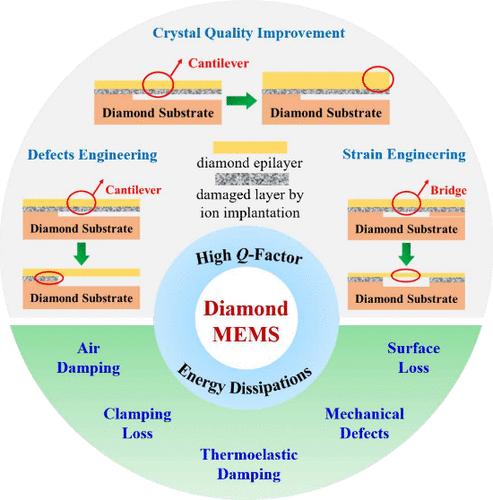当前位置:
X-MOL 学术
›
Acc. Mater. Res.
›
论文详情
Our official English website, www.x-mol.net, welcomes your
feedback! (Note: you will need to create a separate account there.)
Low-Energy Dissipation Diamond MEMS
Accounts of Materials Research ( IF 14.0 ) Pub Date : 2024-07-29 , DOI: 10.1021/accountsmr.4c00139 Guo Chen 1, 2 , Satoshi Koizumi 1 , Yasuo Koide 1 , Meiyong Liao 1
Accounts of Materials Research ( IF 14.0 ) Pub Date : 2024-07-29 , DOI: 10.1021/accountsmr.4c00139 Guo Chen 1, 2 , Satoshi Koizumi 1 , Yasuo Koide 1 , Meiyong Liao 1
Affiliation

|
Microelectromechanical systems (MEMS) that integrate tiny mechanical devices with electronics on a semiconductor substate have experienced explosive growth over the past decades. MEMS have a range of wide applications from accelerometers and gyroscopes in automotive safety, to precise reference oscillators in consumer electrons to probes in atomic force microscopy and sensors for gravitational wave detection. The quality (Q)-factor is a fundamental parameter of a MEMS resonator that determines the sensitivity, noise level, energy efficiency, and stability of the device. MEMS with low energy dissipation have always been pursued. Despite the brilliant progress of silicon-based MEMS due to the mature technology in counterpart microelectronics, the intrinsic material properties limit the sensitivity and reliability, especially for the applications under extreme conditions. Diamond has emerged as the ideal semiconductor material for low-energy dissipation MEMS with high performance and high reliability, owing to its unparalleled material properties, such as extremely high mechanical strength, superelectrical properties, highest thermal conductivity, and chemical inertness. Diamond resonators are thus expected to exhibit high Q-factors, and high reliability, with low thermomechanical force noise and long coherence rate of mechanical quantum states, not only improving the performance of MEMS devices but also expanding to the quantum domain. Single-crystal diamond (SCD) is desirable to achieve the ultralow energy loss or high Q-factor MEMS resonator due to the nonexistence of grain boundaries and other carbon phases. However, micromachining for SCD is tough and heteroepitaxial growth of SCD on foreign substrates remains quite difficult.
中文翻译:

低能量耗散金刚石 MEMS
在半导体基底上集成微型机械设备和电子器件的微机电系统 (MEMS) 在过去几十年中经历了爆炸性增长。 MEMS 具有广泛的应用,从汽车安全中的加速计和陀螺仪,到消费电子中的精确参考振荡器,再到原子力显微镜中的探针和用于引力波检测的传感器。质量 ( Q ) 因数是 MEMS 谐振器的基本参数,决定器件的灵敏度、噪声水平、能效和稳定性。低能耗的MEMS一直是人们追求的目标。尽管由于对应微电子技术的成熟,硅基MEMS取得了辉煌的进步,但其固有的材料特性限制了灵敏度和可靠性,特别是对于极端条件下的应用。金刚石因其无与伦比的材料特性,如极高的机械强度、超电性能、最高的导热率和化学惰性等,已成为高性能和高可靠性低能耗MEMS的理想半导体材料。因此,金刚石谐振器有望表现出高品质因数、高可靠性、低热机械力噪声和长机械量子态相干率,不仅可以提高MEMS器件的性能,而且可以扩展到量子领域。由于不存在晶界和其他碳相,单晶金刚石 (SCD) 非常适合实现超低能量损耗或高Q因子 MEMS 谐振器。然而,SCD 的微机械加工非常困难,并且 SCD 在异质衬底上的异质外延生长仍然相当困难。
更新日期:2024-07-29
中文翻译:

低能量耗散金刚石 MEMS
在半导体基底上集成微型机械设备和电子器件的微机电系统 (MEMS) 在过去几十年中经历了爆炸性增长。 MEMS 具有广泛的应用,从汽车安全中的加速计和陀螺仪,到消费电子中的精确参考振荡器,再到原子力显微镜中的探针和用于引力波检测的传感器。质量 ( Q ) 因数是 MEMS 谐振器的基本参数,决定器件的灵敏度、噪声水平、能效和稳定性。低能耗的MEMS一直是人们追求的目标。尽管由于对应微电子技术的成熟,硅基MEMS取得了辉煌的进步,但其固有的材料特性限制了灵敏度和可靠性,特别是对于极端条件下的应用。金刚石因其无与伦比的材料特性,如极高的机械强度、超电性能、最高的导热率和化学惰性等,已成为高性能和高可靠性低能耗MEMS的理想半导体材料。因此,金刚石谐振器有望表现出高品质因数、高可靠性、低热机械力噪声和长机械量子态相干率,不仅可以提高MEMS器件的性能,而且可以扩展到量子领域。由于不存在晶界和其他碳相,单晶金刚石 (SCD) 非常适合实现超低能量损耗或高Q因子 MEMS 谐振器。然而,SCD 的微机械加工非常困难,并且 SCD 在异质衬底上的异质外延生长仍然相当困难。






























 京公网安备 11010802027423号
京公网安备 11010802027423号